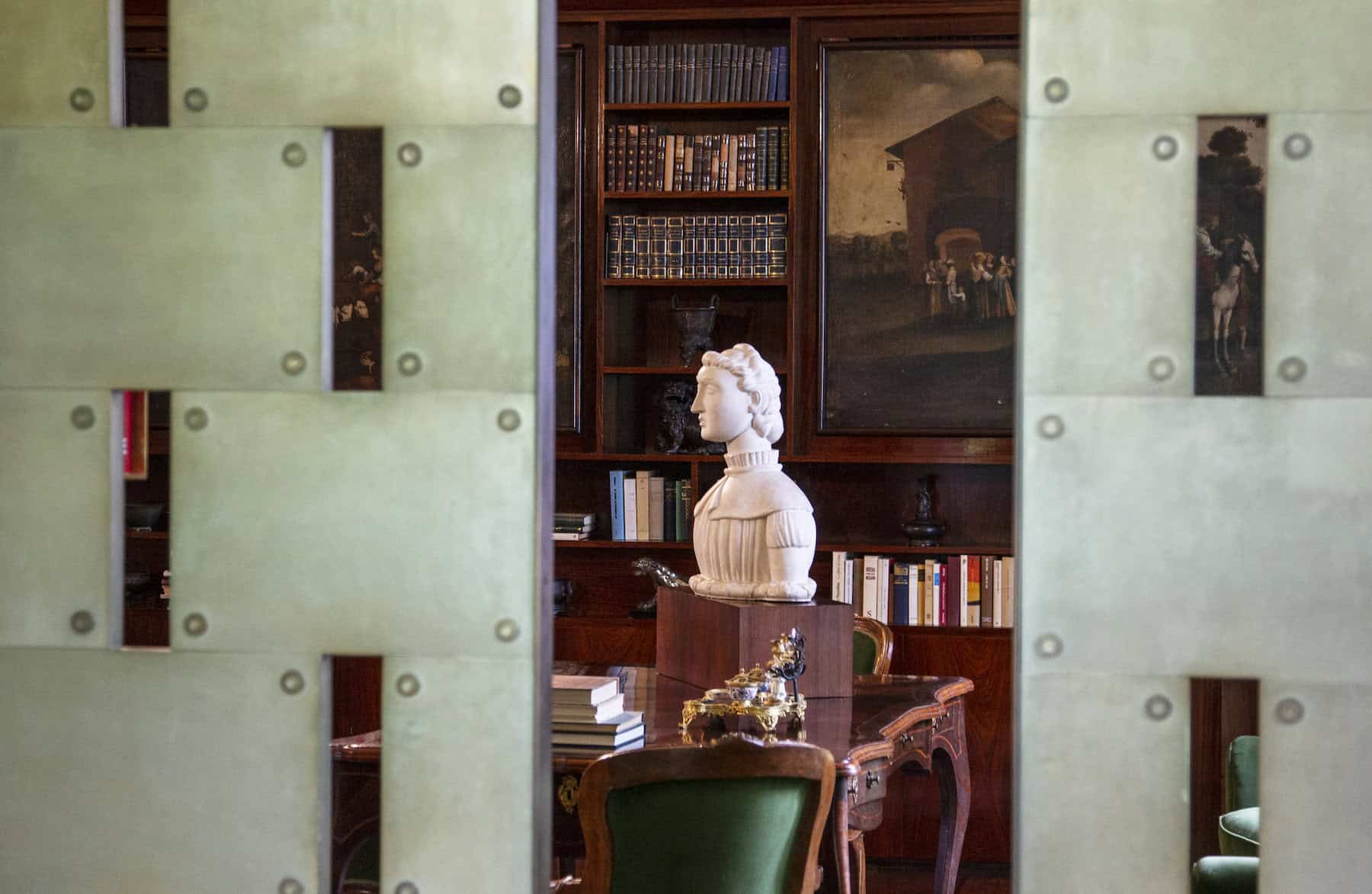Villa Necchi Campiglio.
The tale of Milan’s most cinematic house museum and its architect, Piero Portaluppi.
Few filmmakers evoke such a profound sense of place as the Italian director, Luca Guadagnino. The 17th-century villa in Lombardy that formed the romantically charged backdrop to Call Me By Your Name was one of the most atmospheric abodes to hit the big screen. Another was the dammuso on the island of Pantelleria in A Bigger Splash, with Harry dancing to the Rolling Stones from the vaulted living room and out into the setting sun – cinematic gold that had as much to do with location as Ralph Fiennes’s genius performance. It’s this poetic pairing of casa and characters in both films, the second and third instalments in his Desire trilogy, that leaves an impression more lasting than most. Although having set the bar so high with the trilogy’s first instalment, I Am Love, anything less would have flopped.
For those who haven’t seen it, I Am Love recounts the unravelling of the haute bourgeois Recchi family in Milan at the close of the 20th century, as their textile empire changes hands and the Russian-born matriarch, Emma, runs off with one of her son’s friends, a chef. It’s Italian cinema in the tradition of Antonioni and Visconti but fused, thanks to dramatic camerawork and a brilliant score by John Adams, with moments of Hitchcock-like suspense. Tilda Swinton gives a typically ethereal performance as the repressed, Jill Sander-clad Emma, but stealing the show is Villa Necchi Campiglio, the fascist-era mansion against which much of the narrative takes place.
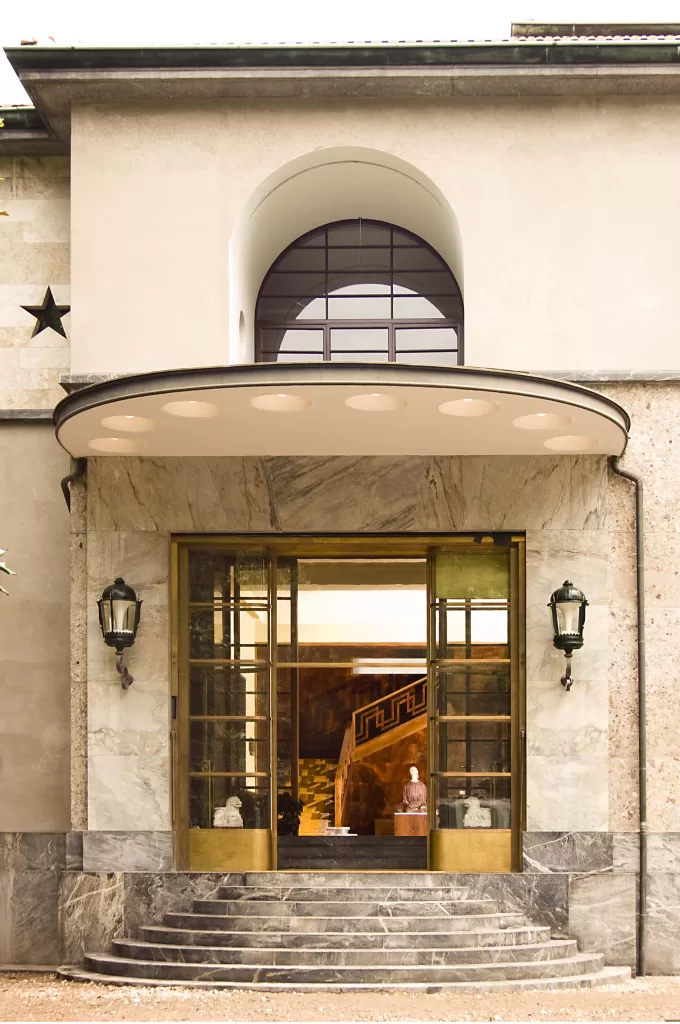
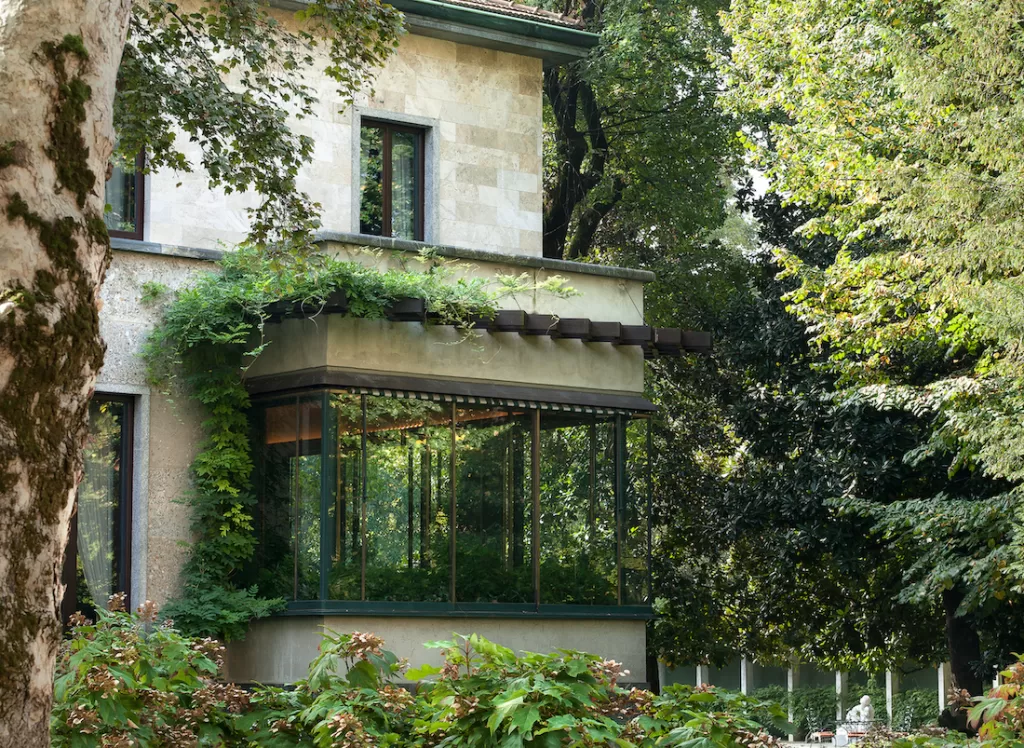
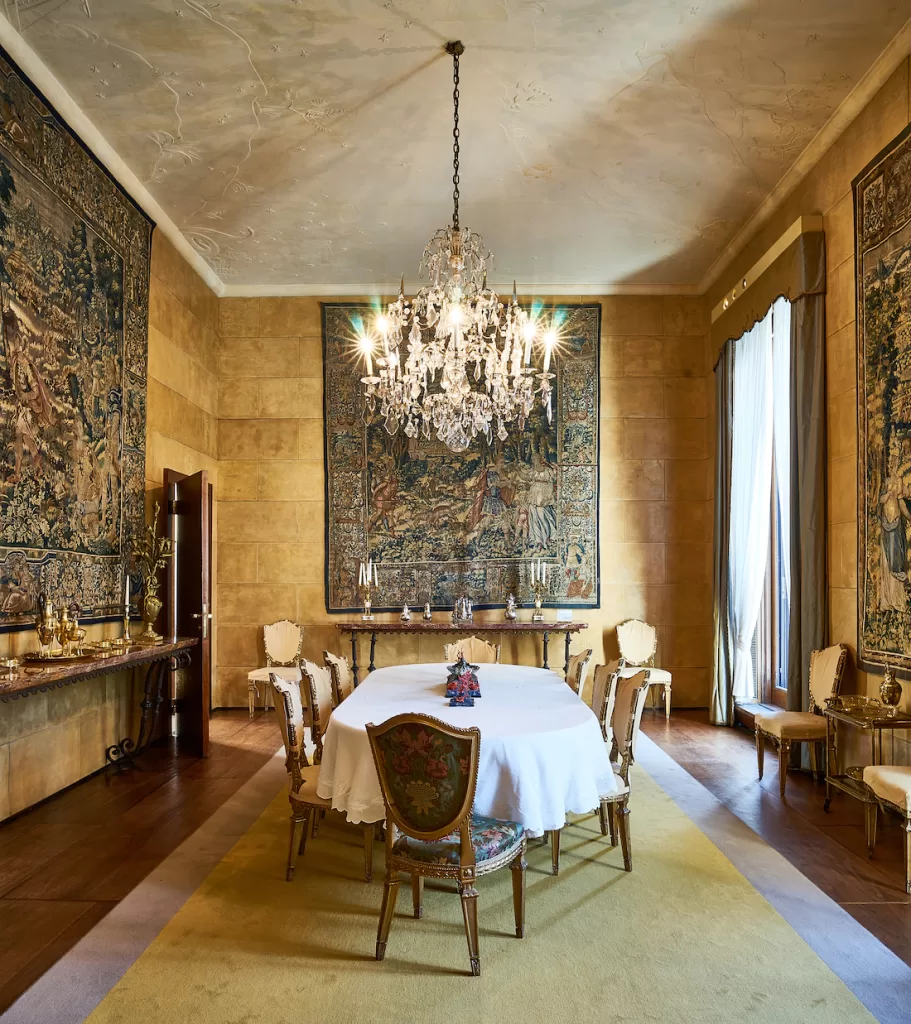
Since opening its doors to the public in 2008, the villa has been a place of pilgrimage for design aficionados visiting Milan and its architect, Piero Portaluppi, who fell into relative obscurity after World War II and died in 1967, has quite the cult following. Further cementing his celebrity, the fictitious Recchi clan is based partly on Portaluppi’s descendants, the Castellini Baldissera family. Various members make cameo appearances in the film and scenes at the home of dowager matriarch Rori – played by Marisa Berenson – were shot at the architect’s own home, Casa degli Atellani. Not bad for a chap who was virtually unknown outside his hometown before the release of I Am Love.
“As an insider of that world in Milan, upon first seeing the movie I focused on its occasional mischaracterisations of Milanese life,” Portaluppi’s great-grandson, Nicolò Castellini Baldissera, tells The Pursuit Of. “But reviewing it, I love that these two houses, Villa Necchi and Casa degli Atellani, could paint such an ideal backdrop. Everyone says Milan is a city best seen from behind closed doors – meaning I guess that you can’t see Milan without an insider’s point of view. Guadagnino certainly invited the world in with his movie, and I love that he used the filter of two of Portaluppi’s best projects to do that.”
Creativity runs in the family. Nicolò’s father, Piero Castellini Baldissera, is an architect and co-founder of the textile house C&C Milano, while his siblings are photographers. Nicolò left Milan when he was 18 and has just moved back after three-plus decades away, bouncing between London and Tangier. He studied art history at Sotheby’s and is now an interior designer. “It took leaving Milan at the age of 18 to realise what a provincial phenomenon Portaluppi was,” he says. “He had few projects outside of the city and hardly any outside of the country. But again, Portaluppi was never considered an obscure architect in Milan – he did the Piazza del Duomo, ran the Politecnico, and did the villas for most of the industrialists – so I didn’t have the feeling of him as underappreciated until later.”
Portaluppi designed and built Villa Necchi Campiglio at the midpoint of his career, between 1932 and 1935, for sisters Gigina and Nedda Necchi and Gigina’s husband, Angelo Campiglio. The wealthy Necchi family from nearby Pavia had made its fortune in metal and machinery, from sewing machines to Fiat components, and held a patent for enamelling cast iron. As legend has it, Angelo and Gigina were on their way home from La Scala one evening when their chauffeur got lost around what is now Via Mozart. The area, composed mainly of fields, sat just outside the bastioni enclosing old Milan, and was being developed to accommodate new streets and residences, elegant and modern, for the city’s burgeoning nouveaux riches. Angelo saw a ‘for sale’ sign and bought the large parcel of land the following day. The design was entrusted to Portaluppi, already established as the go-to architect of the city’s moneyed class.
The villa’s exterior embodies the rationalist spirit of Italian architecture in the 1930s, but with the odd whimsical detail. A curve of over-scaled circular lights illuminates the semicircular portico – circles being a leitmotif throughout much of Portaluppi’s work – and softens the rigorous lines of the façade. As does a tiny star-shaped window above and to the left, an ode to his love of astronomy and the fact that he’d just designed the city’s planetarium.
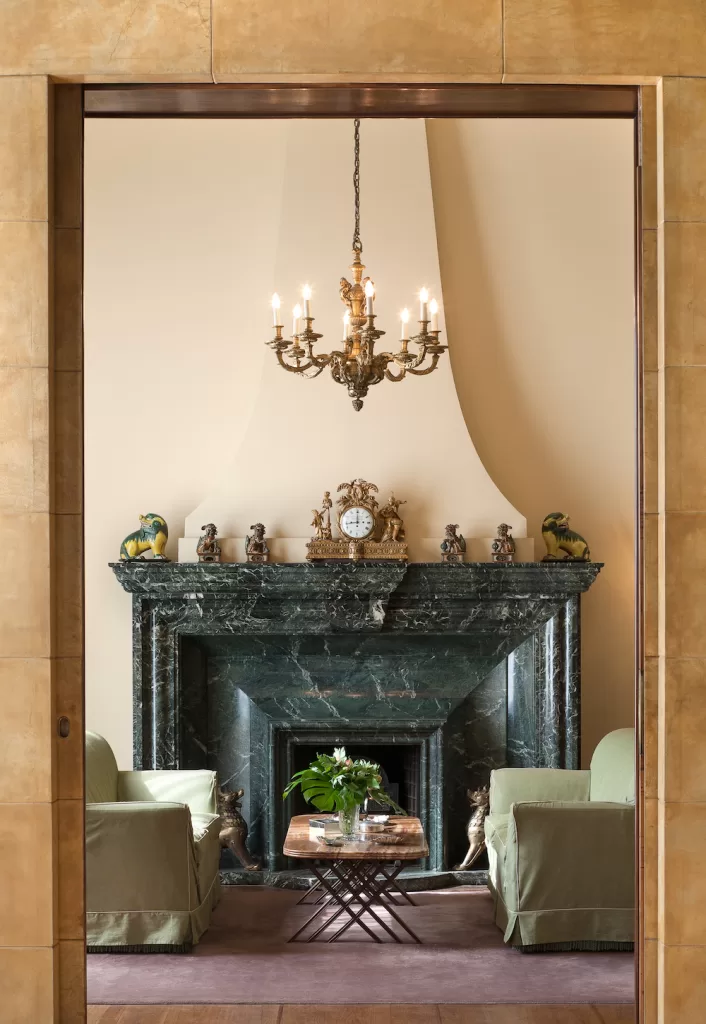

The gears shift slightly inside with a procession of rooms exuding Art Deco glamour. Walnut floors, parchment-covered walls and rosewood detailing make for an atmosphere of luxury and restraint. Lozenges, another Portaluppi motif, are repeated throughout the house, from the brass inlay of the sliding doors in the dining room through to the dramatic, Tudor-like stucco pattern of the library ceiling. Technical innovations included elevators and dumbwaiters through to indoor intercoms, recessed lighting, concealed radiators and electric windows, not to mention a heated swimming pool in the garden – the first private swimming pool in Milan. And bucolic vistas from the enclosed veranda’s large brass windows were rarely interrupted thanks to the service tunnels that ran underneath the garden.
Most striking is the intimacy of Villa Necchi’s orientation and scale. It faces away from the street and into its Arcadian setting, and is generously proportioned but not unnecessarily large. A home of four floors feels more like two, due to the discretion of the lower-ground floor and attic. And while impressive – one enters the villa through monumental double doors in brass and glass – there’s warmth to the sequence of rooms beyond, conceived for comfort and pleasure as much as show.
The family abandoned Villa Necchi in September 1943 on Italy’s surrender to the allies and rode out the remainder of the war at their country house in Barasso, near the Swiss border. The villa was, for a time, used as a fascist command centre and following the regime’s final collapse, was taken over by the British before becoming a Dutch consulate. The family returned sometime the following year. When Gigina died in 2001, the property was left in the care of FAI – Fondo per l’Ambiente Italiano (Italy’s national trust) and after an extensive renovation opened its doors to the public in 2008.
Superimposed over the crisp lines and luxurious finishes of Portaluppi’s interior is a second layer of interior decoration. The work of the architect and designer, Tomaso Buzzi, in the pre-modern style all the rage with the moneyed class in the 1950’s and 60’s, it gives Villa Necchi a wonderfully hybrid feel.
Established in 1999, Fondazione Piero Portaluppi occupies the architect’s former studio on the ground floor of Casa Portaluppi, a building he designed in the 1930’s. The foundation’s objective is to “re-enhance” the work and personality of its multidimensional namesake. Listed in its registry are more than 900 project entries, including 450 in Milan. Of these, 133 were completed and 91 still stand.
The crafting of buildings, though, was only one facet of the polymath’s life. Portaluppi was a renowned cartoonist, creating satirical drawings in the 1910’s and 20’s for Guerin Meschino, Uomo di Pietra and other magazines. He published a book on the architecture of Lombardy in the 1500’s and toward the end of his life wrote a book on sundials and related reflections. He designed furniture – surprisingly playful and sumptuous pieces such as the scalloped-back ‘Modernist Sofa’, reissued by Portaluppi Milano Design and available on 1stdibs – and from 1939 to 1963, was the head of the Faculty of Architecture at the Politecnico di Milano. He described himself as “a man with 25 careers” including philatelist (a person who collects stamps), statistician, filmmaker, traveller and riddler. Director Maria Mauti’s 2016 documentary l’Amatore – The Amateur – splices together a hidden trunk’s worth 16mm footage shot and edited by the architect himself in the 1920’s and 30’s.
Portaluppi was born in Milan on March 19, 1888, to Luisa Gadda and Oreste Portaluppi, a construction engineer. He received his degree in architecture from the Politecnico in 1910 and established his architecture practice the following year. One of his first clients was the energy magnate Ettore Conti, who introduced the large-scale transport of electricity to Italy. “He got his start designing power plants, something so new at the time it had no comparison,” says Nicolo. “He strove to invent a new architecture that, like much of Italian interwar design, sought to revive a neoclassical grandeur that was adopted for the modern era. In retrospect, I think he was having fun – playing with forms and influences from every century. The flagship factory at Verampio had pagoda references and bits and pieces borrowed from every corner of the world.”
The collaboration produced numerous hydroelectric power plants of singular design along the Italo-Swiss border between 1912 and 1930, and through Conti, Portaluppi gained access to the world of Milan’s haute bourgeoisie, leading to both commercial and residential commissions. Their personal association was to be lifelong following the architect’s marriage to Conti’s niece, Lia Baglia, in 1913. “Baglia was both Conti’s niece, by his sister, as well as his daughter,” explains Nicolò, “as she was adopted as a young girl ex sorore as is not uncommon here in Italy to preserve the family name, as Conti had no offspring.” They had two children: Castellini Baldissera’s paternal grandmother, Luisa, in 1914; and Oreste, known as Tuccio, three years later.
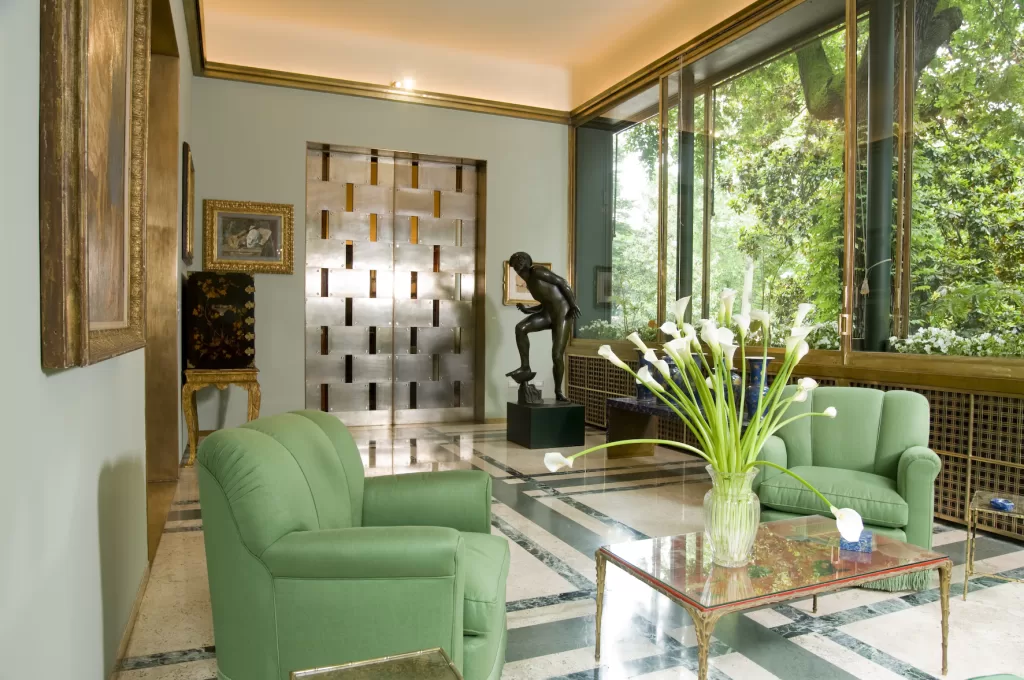

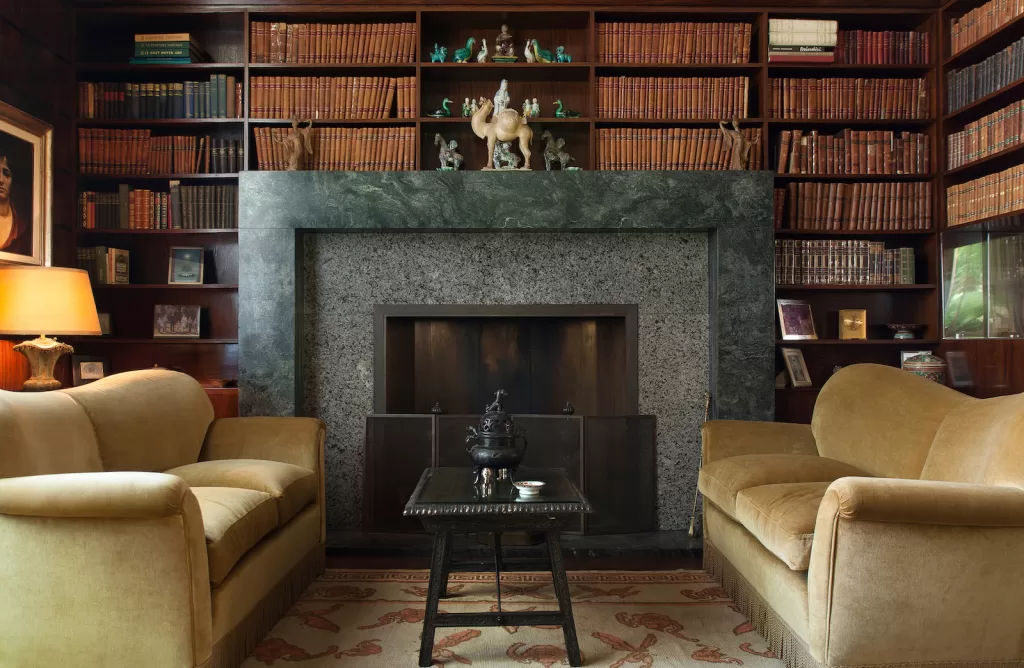

Portaluppi served as an officer in the Engineer Corps during World War I, after which a volley of illustrious projects came in during the course of the 1920s and 30s. Noteworthy examples in Milan include the rococo-inspired Sede per la Società Filatura Cascami Seta (1920-24); the monumental Palazzo della Società Buonarotti-Carpaccio- Giotto (1926-30); Casa Crespi (1927-30) and Palazzo Crespi (1928-32); Planetario Hoepli (1929-30); Casa Radici-Di Stefano, also open to the public (1929-31); Il Palazzo dell’Istituto nazionale Delle Assicurazioni (1932- 37); and Palazzo dell’ Arengario (1937-42, now the Museo del Novecento) after he won the competition to rearrange the Piazza del Duomo. Further afield was the fantastical but unrealised skyscraper S.K.N.E / New York (1920) and the Italian Pavilion at the 1929 Barcelona International Exposition.
Another Milan project of note is Casa Corbellini-Wassermann in Viale Lombardia, designed for the family of German-born bacteriologist August von Wassermann between 1934 and 1936. It was uninhabited for more than a decade, and the main two floors recently underwent an extensive conservation and renovation by Studio Binocle (overseen by architect Antonio Citterio) and now form the flagship gallery of Massimo De Carlo, a contemporary art dealer with spaces in Hong Kong and London. “For years I’d been looking for a place that would allow us to escape the globalised stereotype of art galleries and have a unique and distinctive identity,” De Carlo says. “The time was right to leave the cliché of the white cube for something more inspiring and demanding. Casa Corbellini-Wassermann suits perfectly, challenging the art to deal with a specific context.”
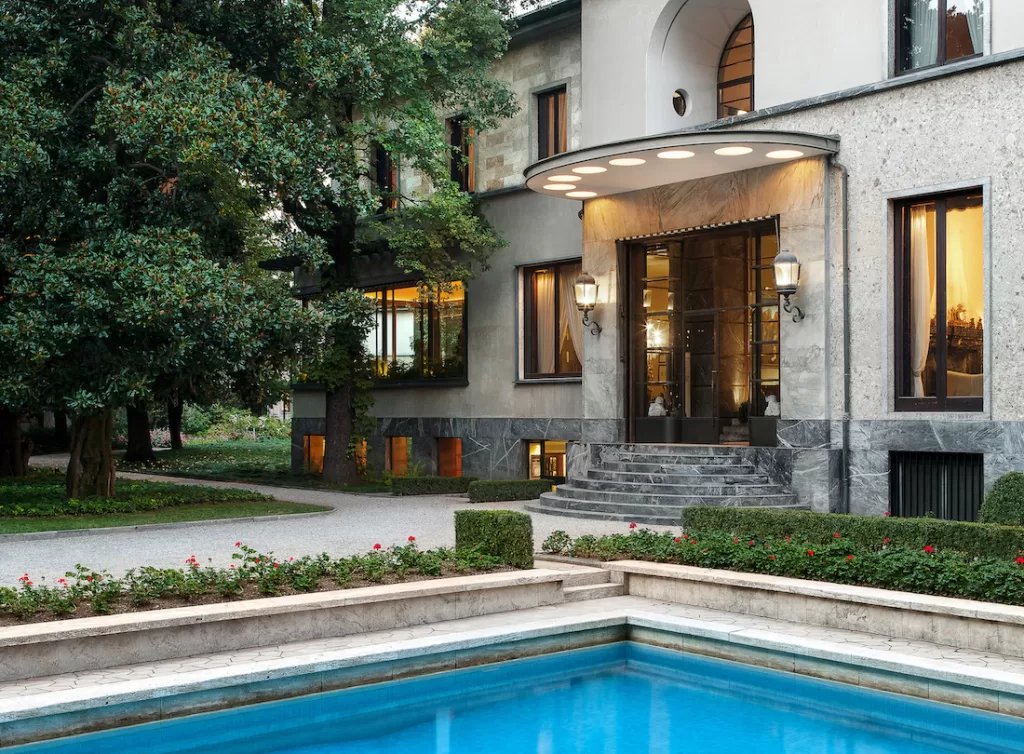

A spiral staircase breaks the severity of the home’s rationalist exterior, which is clad in pink and grey Ornavasso marble. The staircase was designed for another project: the ‘Corbusian’ pavilion Casa del Sabato per gli Sposi (the Saturday house for newlyweds) at the 1933 Milan Triennale, afterwards disassembled and reinstalled at Casa Corbellini-Wassermann. Inside, the millerighe marble floor – “a thousand lines”, according to Portaluppi – leads like a technicolour conveyor belt from one space to the next. Pale yellow walls in the reception room are painted with a map of Milan and the surrounding countryside, highlighting the sites of the Corbellini-Wassermann’s various estates and their favourite game birds, superimposed as if taking flight. “I want the place to change what people see and how they see it,” says De Carlo. “To put things together that have not been together before, in a place that itself is unique.”
Portaluppi’s flair for creating extraordinary environments extended to the restoration of historic buildings. Some dated from the Renaissance, such as the Pinacoteca di Brera (1919-25) and Santa Maria delle Grazie (1944-48), home to Leonardo’s The Last Supper. His most emblematic, though, was Casa degli Atellani for Ettore Conti, where, between 1919 and 1921, he joined, overhauled and meticulously restored two neoclassical palazzi from the 15th century. Portaluppi lived at Casa degli Atellani from 1922 until his death in 1967.
It too has a da Vinci connection. The original owner, Ludovico Sforza, the Duke of Milan, is said to have hosted Leonardo there between 1495 and 1498 while he worked on The Last Supper. He gave Leonardo a hectare of land, upon which the artist planted a vineyard. This now forms a part of the palazzo’s garden – according to Nicolò, Portaluppi’s only major garden design – where the vines still produce grapes. Today the complex is home to the architect’s grandchildren, including Nicolò’s father, Piero. (Piero and his sister Letizia Castellini Baldissera, a biologist, chair the foundation.)
“Where the palazzo is today, there once were two houses – numbers 65 and 67 on Corso Magenta,” says Piero. “In 1919 Ettore Conti purchased them both and asked Portaluppi to transform them. Over the years, Portaluppi managed to make out of them one unique house, tearing down the wall that divided the two, adding a building and reconfiguring the rooms while always maintaining the spaces and the neoclassical exterior.” Casa degli Atellani was partially destroyed – and his son Tuccio tragically killed – during the war, after which the architect embarked on a series of works lasting until 1952, restoring what he could and designing a new facade.
Fascism was a disaster for Italy in all but one area: architecture. Mussolini’s Novecento movement and its crossover with the cool geometries of Rationalism ushered in a period of prolific activity unprecedented since the 1st century AD – and Portaluppi was one of the great protagonist of the era. “Portaluppi’s world coincided exactly with Italy’s fascist period,” says Piero. “He wasn’t more of a fascist than the rest of the Italian population, or more than other important architects of the time, but certainly this coincidence did not do him good. Ironically, today fascist design is a trend!”
Following his parents’ divorce, Nicolò and his siblings gravitated between Casa degli Atellani and his mother’s apartment on the top floor of Casa Portaluppi, the late 1930s building now home to the foundation. (His mother Patrizia, who died in 1998, was a descendant of Giacomo Puccini.) “These two homes are such different visions for living,” he says. “Casa degli Atellani was the shell of an ancient palazzo built in the countryside, turned into a residence for an important family in the city. Casa Portaluppi, on the other hand, is entirely modern. The exterior of the ground floor is covered in metal. But the thread linking them both is the attention to detail and the fun he had, particularly on the small scale. In Atellani he made a small window at the base of the building in the garden in the shape of a butterfly. It’s a small thing but to me it is a tell – a little wink that the building, especially where it faces the garden, is not as old as it might seem.”
Villa Necchi Campiglio is open Wednesday to Sunday, 10am-6pm. To purchase tickets, please go to Fondo per l’Ambiente Italiano (FAI) Villa Necchi Campiglio.
Via Mozart 14, Milan.
Photography: ℅ FAI (Gabriele Basilico, Barbara Verduci, Giorgio Majno, Luciano Monti, Arenaimmagini, Quine SRL) and Fondazione Portaluppi.
From a story originally published in WISH.

